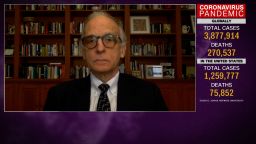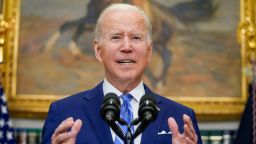Editor’s Note: Kent Sepkowitz is a physician and infectious disease expert at Memorial Sloan Kettering Cancer Center in New York. The views expressed in this commentary are his own. View more opinion on CNN.
The Covid-19 pandemic has supplied us with yet another unexpected and unwanted twist, this time about the antiviral drug Paxlovid, which has been shown to reduce Covid-19-related hospitalization and death by 89% in a group of unvaccinated out-patient adults, according to a recent study in The New England Journal of Medicine.

But, in the last few weeks, reports have emerged that some people who receive the medication develop a “rebound” of symptoms of varying intensity and duration a few days after completion of the five-day course. For some, this included reversion to a positive diagnostic Covid-19 test.
The frequency of the rebound is not well defined. The large clinical trial that resulted in emergency use authorization (EUA) of Paxlovid found that 1% to 2% of persons in both the treatment and placebo groups of the trial had a positive PCR test after an initial negative test post-infection. (Of note, many trial patients were otherwise asymptomatic when they had this post-infection positive result and an increase in hospitalization, death and drug resistance was not observed.) So, the Paxlovid rebound was not expected and the frequency of it is currently unknown.
My guess is that this is occurring more frequently than in 1% or 2% of people. Right now, we only have a series of anecdotes and friends’ worried phone calls. Plus, some of the main symptoms, like sniffles and headache, can be ascribed to allergies or angst or whatever.
I should know… for I, too, am a rebounder. After the first dose or two of antiviral, I welcomed a glorious easing of my symptoms. But then, three or four days after stopping my meds, my nose began to run once more, my morning throat discomfort returned, as did the grinding headache, the low-grade fever and the sudden, even dramatic fatigue that resolved only after a brief, or not so brief, nap.
I wasn’t certain that it was a rebound, so I reached out to doctor friends who also were caught in the latest Omicron wave to exchange stories. To my surprise, many told me that they too had rebounded a little or a lot after finishing their Paxlovid course. Granted, doctors are particularly predisposed to describing even a sniffle or the passing throat twinge in excruciating detail. The challenge of applying hyper-technical medical-ese to our own mortal selves somehow is irresistible.
The complaints I heard from friends though were not simply verbal acrobatics: Some felt lousy enough to miss a day or two of work. Others felt worse than ever. Personally, I dragged for several days, never quite sure if I was ill or milking it a bit – until the sudden fatigue descended at an odd moment and lying down right there on the floor for 40 winks seemed like a great idea.
Though disappointing, the rebound is not a huge surprise, nor does it offset the usefulness of the new drug. Other viruses, when suppressed by antivirals, also can bounce back, sometimes with a vengeance, if antiviral treatment is stopped. For example, people with HIV may experience a new “acute infection” syndrome similar to mononucleosis, while those who stop treatment for hepatitis B may induce a flare of liver inflammation that can be fatal. But these are infections known for their long duration and high level of virus in the blood; neither property applies to the coronavirus.
So once again we are in uncharted Covid-19 waters, trying to use sort-of-similar situations as a guide for what’s ahead even as countless new questions arise.
First, does the rise in the amount of detectable virus during rebound mean a person is again contagious and, if so, does the rule of five days of isolation, five more days of masking no longer apply? (My guess is that a longer stay away from the crowd is necessary.) Second, is there a connection, favorable or not, between rebounding and development of long Covid-19? (I doubt it.)
Will this bounce back predispose to a faster emergence of drug resistance? (So far, no, but data is still being collected.) What about the impact of a rebound on protection against the next variant? It might be wishful thinking, but one could argue that the rebound and re-exposure to virus so soon after the first challenge could lead to a more durable immune response.
These questions lead us to the tiresome but correct bromide that more studies are needed to figure out the implications of this bump in the road.
What is clear is that the hope for a game changer from this particular drug is overly optimistic. Add viral rebound to the list of concerns already raised about the drug: the many drug-drug interactions, frequent appearance of a metallic taste in the mouth and its failure to prevent infection among uninfected close contacts (usually the easiest task for an antiviral). Plus, its efficacy has been shown only in the unvaccinated. Now comes an unexpected and still poorly understood new phenomenon that may create additional public health confusion regarding contagiousness.
Once again, our pandemic fatigue and longing for unrestricted daily life have gotten the better of our judgment. The drug by itself will not stop the pandemic or be a “game changer.” But its availability is an important incremental step: We now have a medication that reduces the risk of hospitalization and death among the unvaccinated by a staggering amount.
As with other substantial steps forward, including effective vaccination, treatment with the steroid dexamethasone, immunity from infection and monoclonal antibody treatment, we have been reminded again that no shortcuts exist in the battle to control the pandemic. Like all real-life struggles, this particular game is very, very difficult to change. But all can agree that, more than two years into the pandemic, the likely fate of a person, aka the “game,” who was infected in March 2020 versus now has been fundamentally changed.




